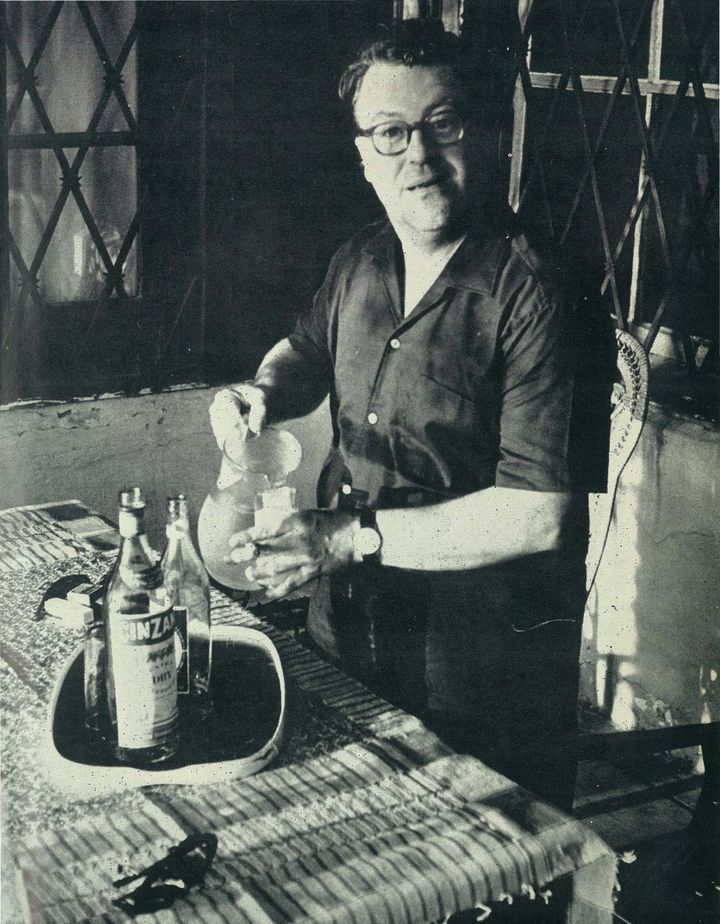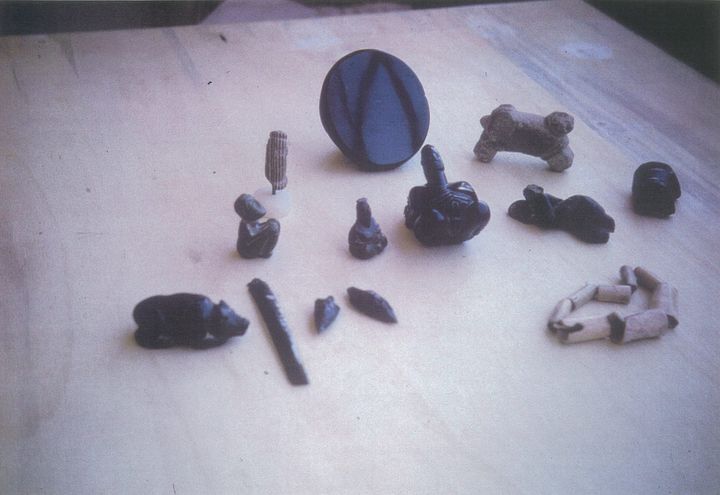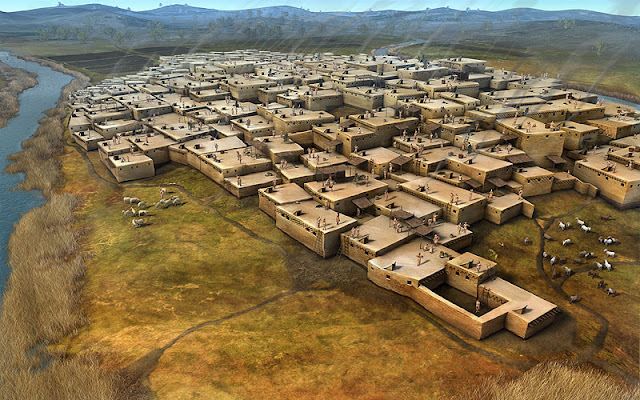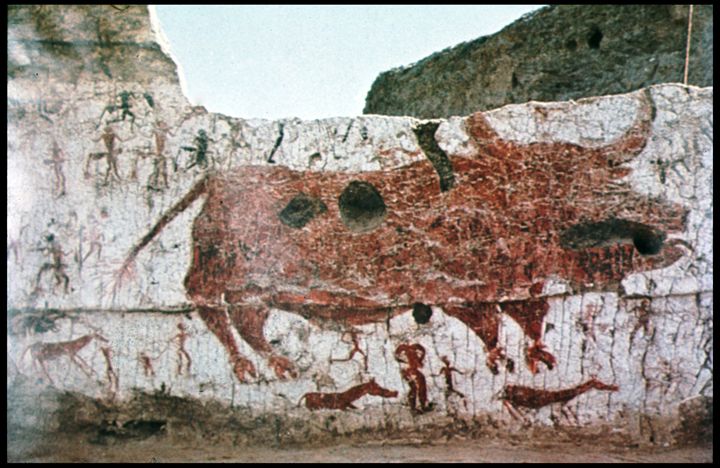
IAN HODDER
I first contacted British archaeologist Ian Hodder roughly a quarter century ago when it was announced that Hodder was reopening Çatalhöyük, the Neolithic site in central Turkey, because I’d been writing about its discoverer, British archaeologist James Mellaart. Çatalhöyük is a 9,500-year-old “urban” settlement, rich in art, covering 32 acres of the Konya Plain. The previous excavation there, Mellaart’s excavation, had been shut down in 1965 by the Turkish government after just a few years of digging because artifacts kept disappearing.

JAMES MELLAART on the Bosphorus
Some of those treasures, including one of the few obsidian mirrors to be found at Çatal wound up in the hands of Aydin Dikmen, a Konya dealer and master of fakes, who I’d also been writing about.

AYDIN DIKMEN COLLECTION featuring obsidian mirror (top, center), obsidian arrowheads, bone necklace and steatopygous figures
But the Turks were upset about the disappearance of other antiquities as well, known as “the Dorak Treasure,” which Mellaart, the most famous archaeologist of his time, claimed to have come in contact with and showcased drawings of in The Illustrated London News. Mellaart said the pieces were illegally dug up from two royal tombs of the Yortan, neighbors of the Trojans, and included figurines of the “Yortan Ruling Class.”

The Dorak Treasure turned out to be a fantasy/hoax created by Jimmy Mellaart – exposed decades later through a bit of detective work by me and Turkish journalist Özgen Acar, working with Mellaart’s correspondence. My published conversation in 2005 with James Mellaart’s friend and former associate, Berkeley archaeologist David Stronach further dismantled the “whole [Dorak] enterprise,” which Stronach described to me as Jimmy’s “dream-like episode.” Stronach and Mellaart were friends of mystery writer Agatha Christie.
But while Mellaart’s influence took a serious hit following the Dorak scandal and bleeding of his excavations in Turkey, Çatalhöyük was catapulted to UNESCO World Heritage Site status. Thanks largely to Ian Hodder, who raised $15M to make the Çatalhöyük project sing.

Twenty-five percent of those funds, though, have come from the Templeton Foundation, known for its pairing of science and religion, which is an issue I take up in the following interview with Ian Hodder.
James Mellaart first visited Çatalhöyük (“forked mound”: Çatalhöyük East and Çatalhöyük West) in 1958 with David French and Alan Hall, colleagues from the British Institute of Archaeology, Ankara, after having noticed the “whopping great mound” from afar in 1952. Mellaart was keen on getting to the bottom of the dozen or so levels that its 3,000 to 8,000 people once occupied there but did little screening of materials or recording.
Excavation at Çatalhöyük has proceeded more scientifically with Hodder as project director and the base of the main mound at Çatalhöyük East, which turned out to be 18 levels, has been reached on his watch. Hodder concludes that inhabitants of Çatal lived collectively in an egalitarian society -- one of Anatolia’s first agrarian settlements -- for roughly 1,500 years, clustered in houses with creamy plastered interiors, roof-only entrances and no streets.

However, as the art demonstrates, Çatal does predate the Women’s Movement for one, and many observers say it’s premature to draw too many sweeping conclusions about the site because it’s still only 5% excavated. There are questions, for instance, about just how scientific Hodder’s interpretation is of a religion existing at Çatalhöyük, based on evidence of tidy houses and a scarcity of fractured skulls.
Mellaart’s “scientific thinking” about Çatal, was that it was a hunt-fertility cult with goddesses giving birth to bulls. And British archaeologist Sir Mortimer Wheeler saw a “curious and sometimes a trifle macabre artistry.”
One of the questions I had for Ian Hodder was whether discussion had been suppressed about the existence of psychoactive substances at Çatalhöyük related to art expression. A wide variety of wildlife sharing the Konya plain during the Neolithic Age -- animal, plant, and fungi – was available for consumption by inhabitants of Çatal. Hodder, himself has said “feasts” took place there.
In the late 1980s, e.g., I interviewed Gerardo Reichel-Dolmatoff, then the preeminent expert on Colombia’s Prehispanic past, for an Archaeology magazine cover: “Colombia’s Lurid Past.” Reichel-Dolmatoff told me that his belief in a link between hallucinatory imagery and decorative design elements in Prehispanic statuary had clearly been reinforced after participating in a yajé session with the Amazonian Barasana when he recorded this (partial transcript):
“The motifs are . . . yes, everything is curvilinear; semicircles, shapes like hearts that are intertwined and then become flowers; suddenly, shapes like a Medusa. Sometimes there are . . . yes . . . again these effects of fireworks. But when – no it isn’t three-dimensional . . .it’s flat and fairly dark. Like a basketry design. Like stained-glass windows . . . colors . . . blots, surrounded by a thick black line. Large, different-colored eyes. These things drawing near are like bodies . . . now they are like large caterpillars, with a lot of quills and fur.”
I recently spoke by phone with Ian Hodder in Oxford about his fieldwork at Çatalhöyük. Hodder is the author of 10 books, among them: The Leopard’s Tale: Revealing the Mysteries of Çatalhöyük and Entangled: An Archaeology of the Relationships between Humans and Things, and the editor of 15 volumes, including a series funded by Templeton related to the Çatalhöyük project: Religion in the Emergence of Civilization (Cambridge University Press, 2010); Religion at Work in a Neolithic Society (Cambridge University Press, 2014); and (forthcoming) Religion, History and Place and the Origin of Settled Life.
Among his honors are: Huxley Memorial Medal (Royal Anthropological Institute), Drexel Medal (University of Pennsylvania), Oscar Montelius Medal (Swedish Society of Antiquaries), National Prize (Turkey Ministry of Culture), Gordon Childe Prize (University College London), and Honorary Doctorates from University of Bristol, UK; and University of Leiden, The Netherlands. He is a Fellow of the British Academy, Royal Anthropological Institute, Society of Antiquaries and Explorers Club.
Ian Hodder is also known for excavations he directed at the Iron Age and Roman site of Wendens Ambo, Essex, UK; the prehistoric site of Ledston, W. Yorkshire, UK; and at Haddenham, Cambs., UK. He’s done ethnographic surveys in Kenya and Sudan and is about to start his last season of fieldwork at Çatalhöyük.
Hodder has taught at the University of Cambridge, University of Paris I – Sorbonne, Leeds University, University of Minnesota, State University of New York – Binghamton, among other institutions.
His PhD is in “spatial analysis in archaeology” from Cambridge University and his BA in prehistoric archaeology (First Class Honors Degree) from the University of London.
Ian Hodder is currently Dunlevie Family Professor of Anthropology at Stanford University.
Our interview follows.
Suzan Mazur: Do you know where James Mellaart’s archives from the 60s are being kept and if the Dorak monograph is among the papers?
Ian Hodder: I take it you know his main archives were burned in the fire in a yali on the Bosphorus. There’s very little in the way of documentation about any of his excavations, but particularly about Çatalhöyük. He did have a study room full of material when he died and I believe that what is happening with that is that it’s being transferred after being sorted out. It’s being transferred to University College London. I’m not quite sure what you mean about a Dorak archive or dossier.
Suzan Mazur: With the Dorak drawings, etc.
Ian Hodder: I actually don’t know where those are. I’ve never seen them. They may be amongst his archives, but again, I don’t know. The person to talk to about that is Shahina Farid, who is linked to the British Institute in Ankara.
Suzan Mazur: I last spoke with Alan Mellaart about this after his mother died and he said the Dorak material hadn’t turned up so far and he was trying to decide where to house the archives that were in the London residence of his father.
Ian Hodder: Right.
Suzan Mazur: What was it like working with Jimmy Mellaart?
Ian Hodder: I’m not quite sure what you mean. I never worked with him.
Suzan Mazur: You didn’t.
Ian Hodder: I was a student, so I went to a few of his lectures, but I never worked with him in any way.
Suzan Mazur: But James Mellaart was an adviser to your excavation, wasn’t he, after you reopened Çatalhöyük?
Ian Hodder: Yes.
Suzan Mazur: Was he there on-site? Wasn’t he on-site some of the time?
Ian Hodder: I wouldn’t say that he worked with us. He visited maybe three times for an afternoon. And that was it. He really didn’t try to offer any advice. I talked to him a lot, as much as I could. I visited him every year in his flat in London and talked to him about what we found and showed him pictures of the season. And in all those ways he was very generous with his time and interest and his support. Always interested in what we found. And always willing to tell a good yarn or two about what he had found. But I can’t really say I ever worked with him. He was very genial, very congenial, a great raconteur. Very fun to be with.
Suzan Mazur: Who takes over the dig from you at the end of this year? I think you’re moving on.
Ian Hodder: There is someone who’s taking over but he has asked me to keep his name confidential. So nobody knows at the moment who he is except for me and a few other people.
Suzan Mazur: Are you moving on to another site or just taking some time off?
Ian Hodder: I’m finishing and retiring.
Suzan Mazur: I’ve read that you brought in roughly $10M in funding to the Çatalhöyük project. Is that correct?
Ian Hodder: I’d make it more like $15M.
Suzan Mazur: How much of that has come from the Templeton Foundation?
Ian Hodder: I don’t know to what extent Templeton is happy to have these numbers bandied around. Do you know?
Suzan Mazur: Some of the information is on its web site, on its grant database.
Ian Hodder: If you could have a look at its web site, I’d prefer it. Just off the top of my head I would say it was around $4M, but I don’t know. I haven’t checked really. I’ve had about four different grants from them and I haven’t added it all up.
Suzan Mazur: I’ve also read that you served on the Templeton Board of Advisors at some point. Is that right?
Ian Hodder: Yes.
Suzan Mazur: Can you say when that was?
Ian Hodder: It should be part of the public record. I can look on my CV if you really needed to know. I would say it was between 2010 and 2013, somewhere around there.
[Note: Ian Hodder’s CV indicates he served on Templeton’s Board of Advisors four years: 2010 — 2014.]
Suzan Mazur: Was that a paid position?
Ian Hodder: I don’t remember it being paid. There were certain [funds] for travel to Board meetings but I never went to any of those. I’m afraid I don’t remember if there was anything else.
Suzan Mazur: Templeton is known for its pairing of religion and science, inserting the divine in science. I was wondering if you see any conflict of interest in serving on the Templeton board and accepting these four grants from the foundation relating to Çatalhöyük, three of which pertain to so-called “religion” at Çatal – considering that there was no religion 10,000 years ago?
Ian Hodder: Yes. Well there are a lot of issues there. I was not serving on the Board that gave out money, so I was not in any conflict of interest. I was on an Advisory Board that advised in terms of research and that sort of thing. I was not involved in any way that determined how money was spent. So I didn’t see a conflict of interest. I found that Templeton was very careful to avoid anything like that.
As far as the question of religion is concerned. It rather depends how you define religion. But I’ve now written or published three books that talk about religion in prehistory and I think it’s quite acceptable to define religion in such a way that religion is something that does happen amongst all humans, even amongst non-humans. The idea of the spiritual is a very general notion.
Suzan Mazur: You also gave Paul Wason a 32-page chapter in one of two of the books on religion at Çatal that you edited and that Templeton funded. Wason, at the time was Templeton’s science and religion administrator. You don’t see any conflict there?
Wason’s career – he has a PhD in anthropology but his career is largely as a college and foundation administrator. His field experience is very limited.
Ian Hodder: That’s right. But he wrote quite an important book called The Archaeology of Rank that shed a lot of light on Çatalhöyük. It was well, well before I knew him and I think before he was involved in Templeton. But it was about inequality in prehistoric societies and he discussed Çatalhöyük at some length. I did not see and do not see any reason why someone who has contributed to the discussion about Çatalhöyük – there are very few people like that – should not be involved in the discussion.
Suzan Mazur: I’m asking this because Templeton has come under fire for putting its fingers all over science from the investigation of the origin and evolution of life to space science. It’s perceived that the foundation is compromising the work of scientists and retarding science.
Maurice Bloch, one of your own Çatal book authors has said pursuing a religion angle at Çatal is “a misleading wild goose chase” because humans only thought up religion 5,000 years ago at the earliest. Bloch says humans largely live in their reflective imagination, something that first arose 40,000 to 50,000 years ago. Here’s the Bloch quote:
“The Templeton initiative that led to the publication of this book was about religion at Çatalhöyük, yet this chapter has not mentioned the word once. This is no accident. The reason is that I am confident that there was no religion in Çatalhöyük, any more than there was among the Zafimaniry before Christianity arrived there. Looking for religion is therefore a misleading wild goose chase. . . . The kind of phenomena that the English word “religion,” and the associated word “belief,” can be made to evoke have, at most, a history of five thousand years. This is thousands of years after the establishment of Çatalhöyük.”
What is your response to this?
Ian Hodder: Yes, well that’s fine. That’s Maurice’s view. I just think he’s wrong. He’s one author. I don’t know how many authors came to Çatalhöyük to discuss this issue. It must be well over 30 by now. He’s the only one who takes this extreme position.
Suzan Mazur: Many of those authors are religious scholars.
Ian Hodder: We’ve had many fascinating seminars about this, in which he [Maurice Bloch] has taken one view and other people have taken another view. Many scholars find his definition overly narrow and I certainly do. He’s a wonderful scholar and I have great respect for him, but he’s defining religion in a really narrow way. He’s really talking about religious institutions.
Suzan Mazur: I think it’s important that you included his chapter in the book.
Ian Hodder: He said in that chapter that there’s no religion in Çatalhöyk, only houses or some such phrase like that. But he goes on to say that these houses have great spiritual power. It’s all really a matter of a word game, as far as I’m concerned.
Suzan Mazur: But I’ve seen no in-depth discussion of euphoria-inducing substances used at Çatal, the kind of psychoactive substances that can catalyze human self reflection and imagination – even though the wall art at Çatal suggests that a certain euphoria was experienced. Why have drugs and alcohol not been discussed in your project’s reports and books?
Ian Hodder: Early on in the project we encouraged David Lewis-Williams to work with us and he published various articles and books in which he made those sorts of claims. I’m afraid I don’t find them very convincing. There’s no evidence for them. It’s absolutely possible and very likely that alcohol and drugs were involved but to say that that was the cause of designs on the walls, the particular motifs and the paintings goes too far. I’m quite happy to admit that it existed, but I’d just like to see some evidence that it had an impact on anything.
Suzan Mazur: Ken Pearson & Patricia Connor said in their Dorak Affair book that the inhabitants of Çatal made wine made from hackberries, etc. That information must have come from Mellaart. They also had cherries, plums, figs, according to later Çatal accounts. And juniper berries, which is the basis for gin, making gin. Nut oils from almonds and pistachios – nut oils can also be made into a mind altering substance. Cereal with milk digested produces opioid peptides.
Malting was already a practice with the Natufians, prior to Çatal, and was probably done at Çatal as well since they had wheat cultivation, etc. Poppy seeds have been found at Çatal. And considering that Turkey now has the largest alkaloid plant in the world nearby at Afyon – it is not unreasonable to think that poppies grew wild as early as 10,000 years ago in the region. Hemp (cannabis sativa) has been found at Çatal.
There were marshy areas where mushrooms were no doubt available. Cattle dung used for fuel, could also have provided psychoactive (psilocybin) mushrooms – also used by the Natufians. Syrian rue containing harmine and harmaline was found at Çatal, I understand. It seems this area of discussion has been suppressed regarding Çatalhöyük.
Ian Hodder: If it has been suppressed, it’s because there’s no evidence for it. All the things you’ve listed there were could-have-beens. There is no actual evidence for uses of any drugs or alcohol. Opium seeds, poppy seeds are used as a food, as a flavoring as well as opiates. Opium has a long, long history that appears later on. As I said before, it’s quite possible, that things happened. But my research is evidence-based. Unless I have some evidence I’m not going to make claims.
Suzan Mazur: Have you said that you think the people of Çatalhöyük migrated from the Levant, that they may have been Natufian?
Ian Hodder: I never said that. I don’t believe I’ve said anything about the origins of the people, except in a very general sense. The Neolithic spread from the Middle East.
Suzan Mazur: Has there been some success with DNA analysis of bones and teeth at Çatal establishing a link with other people in the Ancient Near East?
Ian Hodder: No. The preservation of DNA regarding Çatalhöyük is very, very poor, and although we’ve had large projects and spent a lot of money trying to get actual DNA out of it, so far it’s failed. We have a new program that’s being carried out at the moment by a team based in Turkey in collaboration with Danish and German labs. They claim to be making more progress. So maybe within the next six months or so we’ll have some better results. But even from them my impression is that the stuff that they’re getting is very fragmentary. So we can’t say anything at all yet about the origins of the people of Çatalhöyük.
Suzan Mazur: They look to be tall and lean in the murals, in the frescoes.
Ian Hodder: That’s not what we’re getting from the human remains. The human remains of which we have well over 800 and nearly 1,000 complete bodies do not suggest tall people. They’re small and wiry people.
Suzan Mazur: Have you compared them with the Natufian remains?
Ian Hodder: Yes, that’s published in the recent 2013 volumes by Cotsen Press. There are charts that show the overall stature of human size at Çatal in comparison with people throughout the Middle East beginning way back in the Epi-Paleolithic. Generally there’s a sort of gradual change through time, a decrease in size.
Suzan Mazur: A decrease in size. Would that have something to do with the concept of neoteny?
Ian Hodder: No. I think it’s normally thought to do with diet and activity.
Suzan Mazur: Has there been any evidence of ancient dental repair?
Ian Hodder: No dental repairs that I’m aware of. We have a good record of decay.
Suzan Mazur: There was a story a couple of weeks ago about a 13,000 year old tooth or two found in Italy where the pulp, the tissue had been removed and filled in with a type of bitumen and plant fiber.
Ian Hodder: That’s interesting. I didn’t see that. We certainly have not found anything like that at Çatal. That’s very interesting.
Suzan Mazur: I’ll send you the story. What diseases were evident at Çatal?
Ian Hodder: Most diseases don’t show in the bone and so the diseases we’re seeing are largely work-related, stress on the body.
Suzan Mazur: I read something about disease at Çatal being identified from tooth plaque.
Ian Hodder: Yes, we do have people working on the plaque, looking at microbiomes, bacteria and so on that’s in the plaque. Also looking at diet inferred from the plaque, but we don’t have any results of that yet. The main diseases we’re looking at are bone-decay diseases, like osteoporosis, and thinning of the cranium, which has to do with nutrient deficiencies in some people. They’re trying to link that to malaria, etc. All we can really say is that there was quite a lot of bone decay and bone loss with age and with labor and hard work. But, on the whole, Çatalhöyük people actually seemed remarkably healthy.
One of the things we’re interested in is why is that. Because it was a very dense agglomeration of people with lots of rubbish and refuse. So why don’t the people at Çatal show more evidence of disease?
One of the factors seems to be that they managed refuse very, very carefully. They burned it and buried it with clay and covered it over with ash. They also cleaned out their houses very carefully and very frequently, and replastered the insides of the houses.
Suzan Mazur: They had a rich diversity of foods to choose from.
Ian Hodder: Yes.
Suzan Mazur: A varied kind of climate.
Ian Hodder: Yes.
Suzan Mazur: What’s your best guess as to what became of the population?
Did the people of Çatal move further West? Were they ravaged by plague? Overtaken by invaders? What are your thoughts?
Ian Hodder: As I think you know, life at the main mound we’re talking about – Çatalhöyük East – ended after a thousand years but then another mound grew up on the other side of the river at Çatalhöyük West and life went on there for another five hundred years. At the same time that this is going on, around 6,000 BC many other sites emerged on the Konya Plain. So what seems to be the case is that the population expanded onto many other sites on the Konya Plain. But I also think that a rise in population led to a fissioning off and spreading westwards. Because about this time, the late 7th millennium [BC], you have the Neolithic spreading into Northwest Anatolia and then into Southeast Europe. So my view is that there was an indigenous local development that led to expansion of population that then spread to Europe.
Suzan Mazur: Will your upcoming book funded by Templeton at Çatalhöyük be a narrative or another volume you edit?
Ian Hodder: Do you mean the one that is called Religion, History and Place and the Origin of Settled Life?
Suzan Mazur: Don’t you have one coming up on the Neolithic mind?
Ian Hodder: There’s an edited volume coming out with Colorado Press called Religion, History and Place and the Origin of Settled Life. That does come from a Templeton grant, although the grant is not being used for publication. The only other edited volume I have coming out results from a completely different project, which is funded by Imitatio and the Thiel Foundation and that is about violence and the sacred. It’s called: Violence and the Sacred in the Neolithic.
Suzan Mazur: I thought you had something coming out on the Neolithic mind.
Ian Hodder: It’s very unlikely I would publish a book on the Neolithic mind. I don’t believe in that so I don’t know what that could be.
Suzan Mazur: There was one further point. Watching your Google presentation with reference to Göbekli Tepe in Southeast Turkey and the monoliths, how are they dating the stelae? I thought you couldn’t really date carvings on stone.
Ian Hodder: Yes, on the whole that’s true. But the way they’re dating is by looking at broken fragments of stone found with carvings on them in archaeological layers, and dating those archaeological layers. They can date the layers using Carbon 14. So that’s the inference they’re making. The other way is to date the layers of occupation covering the stone.
Suzan Mazur: Will you be involved at all in Göbekli Tepe?
Ian Hodder: No
Suzan Mazur: Is there a final point you’d like to make?
Ian Hodder: Going back to your questions about the Templeton Foundation. The Templeton Foundation has never put any pressure on me to define religion in any particular way or to come up with any particular results about religion. It’s been entirely pressureless as far as I’m concerned.
